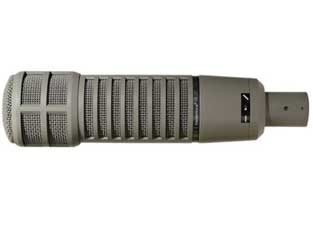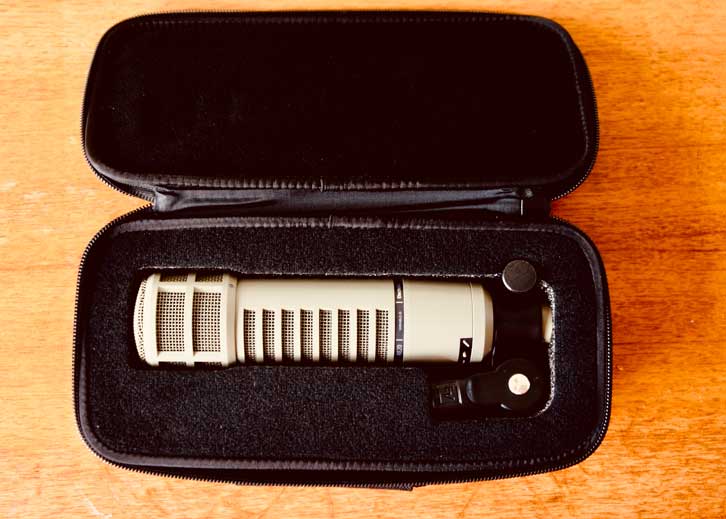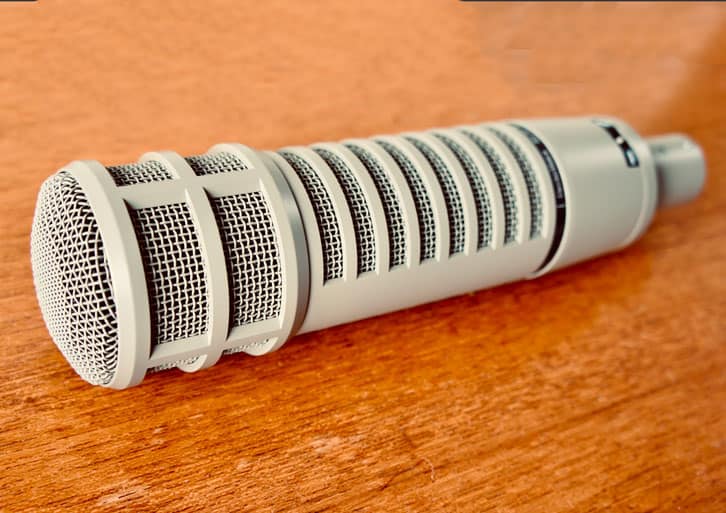Summary and Rating: RE20 vs SM7B
Electro-voice RE20
Shure SM7B
Our Overall Rating
5.0 (out of 5)
4.9 (out of 5)
Pros
pros RE20
- Iconic broadcast sound
- Detailed top end for a dynamic mic
- controlled proximity effect
- great on kick drums, trumpets, and loud amps
- versatile
- good for recording in untreated environments
pros SM7B
- Iconic broadcast sound
- versatile
- warm, flattering sound on most everything
- good for recording in untreated environments
Cons
cons RE20
- Internal shock mount could be better
cons SM7B
- Heavy
RE20

Check Price:
SM7B

Check Price:
Bottom Line
These are the two most popular mics for broadcasting for a reason. You won’t be disappointed with either of them.
The Two Most Popular Broadcast Mics Compared
We’ve been getting a lot of questions lately about mics for spoken word. In particular, readers want to know how the classic sound of the Shure SM7B holds up to two of its biggest rivals in a head-to-head matchup.
The two rivals are the Electro-voice RE20 and the Shure MV7, the two most popular broadcast mics on the market. (See our post, Shure MV7 vs SM7B for a close-up on that duel)
In this post, we focus on the Shure SM7B vs Electro-voice RE20 comparison. This is an apples-to-apples comparison: two dynamic microphones in the same price class with reputations as broadcast recording legends.
See here for all of our gear reviews.
Who are these mics for?
Both the Electro-voice RE20 and the Shure SM7B are dynamic microphones for professional recordists of all types, particularly those interested in spoken word applications.
Dynamic mics tend to have very little self-noise, excellent rejection of unwanted background noise, and they do not require 48V phantom power to operate.
Although each mic will match differently with your voice, mix, and taste, both mics deliver excellent results on sung vocals.
Typically, engineers prefer to use them differently in musical applications due to the way they handle proximity effect (a boomy bass effect that happens when you move the sound source closer to the mic).
With its Variable-D design, the RE20 is known for having a large sweet spot and very little proximity effect. This makes it ideal for recording loud instruments like trumpets and kick drums, producing minimal alteration of the sound.
The SM7B on the other hand has a rather pronounced proximity effect which can be used to your advantage when you would like more bass from your sound source.
Who are these mics NOT for?
Both of these mics are NOT recommended for the following applications:
- applications that require different polar patterns other than cardioid
- applications that require the lush detail and high sensitivity of a condenser mic
- recording ensembles, or the ambient sound of a room.
- Field recording. For field recording, we would recommend the Shure MV88
Alternatives to these Microphones
Shure MV7
A cheaper alternative to the SM7B. Not as versatile or flattering, but quality nonetheless.

Check Price:
Shure SM7dB
Same mic as the SM7B with an onboard preamp giving you up to +28dB of clean gain.

Check Price:
Rode Procaster
A solid, cheaper mic for the spoken word.

Check Price:
Neumann TLM 102
A great choice if you need the detail that only a fine condenser mic can offer.

Check Price:
What’s in the box?
Electro-voice RE20
- The Mic
- Zip-up carry case
- Mounting Nut

SM7B
- The Mic (With built-in shockmount system and pop filter)
- Detachable Windscreen
- Built-in yoke mount
Build / Design
Electro-voice RE20

The RE20 is a fixed-cardioid, dynamic mic with a tank-like rugged build weighing in at 737 grams. It has a low impedance of 150 Ohms (same as SM7B) and a sensitivity of 1.5 mV. The EV RE20 is more sensitive than the SM7B, meaning it requires less gain from your preamp.
Like the SM7B, the RE20 has an internal shockmount to reduce handling noise and a humbucking coil to guard against interference. It is also equipped with a pop filter to reduce plosives.
In our tests, the shockmount in the RE20 was less effective at reducing the sounds of mic stand bumps and outside rumble than that of the SM7B.
The RE20 has an onboard high-pass filter that cuts below 400 Hz with more subtlety than most high-pass filters. It only cuts 2.25 dB off the sound as opposed to a typical -5dB.
Its innards have an output transformer, which gives it an interesting harmonic coloration that is not found in most modern dynamic mics.
SM7B

The SM7B is a good-sized mic. With its built-in air-suspension shock and vibration isolator, she weighs 784 grams and will require a strong mic stand. The mic has the same low impedance as the RE20 (150 Ohms).
On the backplate of the mic, you’ll find switches for bass roll-off, and presence boost (upper mids).
The low sensitivity of the SM7B (1.12 mV) means the mic requires more gain (about 60dB) from your preamp than most condenser mics. If your interface or preamp doesn’t have enough juice, we recommend using either the SM7dB (same as SM7B with an onboard preamp) or the SM7B with a Cloudlifter . Both options will ensure you have enough gain in any recording set-up.
Re20 vs SM7B Frequency Response Graph

Electro-voice RE20 vs Shure SM7B Test Drive
As a reminder, we test everything on this site ourselves.
We used a Universal Audio Apollo Solo Interface recorded with Logic Pro X. There is no EQ or compression applied to any of the audio clips here. We adjusted the gain from the audio interface to taste. In our tests, the SM7B always required more gain on each test.
Full disclosure: We fully acknowledge that there is no one way to use a microphone. Mic placement, how you play or sing, not to mention EQ, compression, Impedance, and preamp settings can all have dramatic effects on the final result.
Electro-voice RE20, Spoken Vocals Tests
SM7B Spoken Vocals Tests
Electro-voice RE20, Sung Vocals
SM7B Sung Vocals
Conclusions about the sound
Electro-voice RE20: Final Thoughts
Electro-voice RE20

Check Price:
This was the first time we were able to get our hands on the RE20. It did not disappoint.
With its balanced frequency response, nothing is over-hyped. The neutral response gives you clarity in all registers.
For spoken word applications, it gives you a silky broadcast sound out-of-the-box, with no fiddling necessary.
The top end is more detailed and sparkly than most dynamic microphones. On the sung vocals, we loved the results.
The controlled proximity effect means it is extremely useful in any studio or on the live stage if you need a reliable mic that can handle trumpets, kick drums, and loud amps.
Overall, we can highly recommend this mic. Personally, if I had to choose, I think this mic has a slight edge over the SM7B because of its outstanding results with spoken word and its versatility.
SM7B: Final Thoughts
Shure SM7B

Check Price:
The SM7B delivers an iconic, smooth performance with a wide range of applications. In addition to its iconic spoken word performance, it works wonderfully on sung vocals, guitars, and other musical applications.
The advantage of the SM7B is its ability to emphasize sound sources in a smooth, flattering way. Its sound is not always the most accurate or realistic, but it will always sound rose-colored in a warm, SM7B kind of way.
The sound is less detailed, which is sometimes a good thing. Its proximity effect can be used to your advantage by simply placing the mic closer to the source for the added low end.
Questions or Comments?
Follow the discussion here on Facebook.